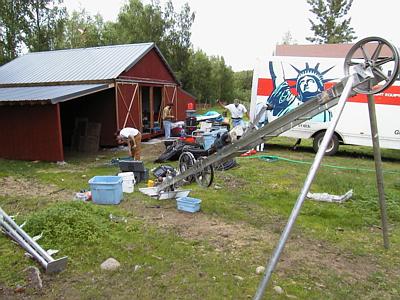
|
|
27 June, 2000
June 27, 2000
We are still in Anchorage. Mountains of gear is being organized and packed,
and logistics are being strategized. Much was accomplished today and we are
nearly ready to leave for our field site in McCarthy. The helicopters will
arrive in McCarthy on Saturday, July 1 (3 days from now) to transport us, and
our equipment to the drill site on the glacier, the camp at the lake, and the
surveying station on the bluff overlooking both the lake and the glacier. So
we need to be leaving Anchorage by at least Thursday afternoon June 29.
Today, PI Andrew Fountain, PSU grad students Michelle Cunico and Don Lindsay,
and myself assembled and tested the drill. The drill is owned by the
University of Wyoming and is stored at a farm located 15 miles north of
Anchorage. The drill was last used by us, and that was a year ago. So, our
morning began by pulling a mountain of "stuff" from a barn. This "stuff"
included the drilling equipment. The goal for the day was to set up and test
the drill to make sure it was operating properly, and then load it into the
U-Haul.
The drill in this case is pretty unique. It is not the typical auger-type
drill used to drill through soil and dirt. This drill is meant to bore
through ice, and to do so it uses a stream of hot, pressurized water extruded
from the tip of a hollow drill stem through a narrow opening - it is the
narrow opening that creates a pressurized flow of water from the stem. The
hot water melts through the ice, making a borehole toward the glacier bed.
There are three main components to the infrastructure of the hot water drill.
The water plant consists of a diesel-powered pump that pulls water through a
garden hose from a nearby pool and delivers it to the heating plant. The
heating plant consists of an on-demand water heating system. A series of
copper coils are wrapped around a diesel-fired flame, which heats water as it
passes through the coils. The hot water enters a stiff, polyvinyl hose - up
to 600 meters long - which terminates at a "stinger". The stinger is a long
and very heavy brass extension that delivers the pressurized hot water to the
ice. The final component is the power plant, which is a diesel powered
electrical generator that powers a pump that delivers a controlled amount of
diesel to the heating plant. The power plant also provides electricity to a
pulley system that controls the rate at which the hot water hose is delivered
into the advancing borehole. It is a pretty elaborate system. We spent a
few hours today assembling and testing the entire drilling system. When PSU
grad student Michelle Cunico reported to us that a hot spray of water was
emanating from the stinger, we knew that we were in business.
Two more people on our project arrived in Anchorage today. U.S. Geological
Society scientist and PI Joe Walder, and St. Olaf College undergrad Andrew
Malm joined the rest of us for dinner. We all worked on this project
together last summer. It was like old times.

The hot water drill is stored in a barn on a farm outside of Anchorage. Today we pulled all of the gear out of the barn and checked to confirm that the drill was working properly. Those in the photo, from left to right include PSU grad student Michelle Cunico, PSU glaciologist Andrew Fountain, and PSU grad student Don Lindsay.

Contact the TEA in the field at
.
If you cannot connect through your browser, copy the
TEA's e-mail address in the "To:" line of
your favorite e-mail package.
|
